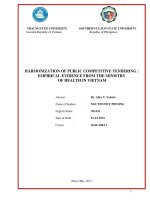Custommer centric marketing , empirical evidence from logistics sector in vietnam
Bạn đang xem bản rút gọn của tài liệu. Xem và tải ngay bản đầy đủ của tài liệu tại đây (597.81 KB, 75 trang )
UNIVERSITY OF ECONOMICS HO CHI MINH CITY
International School of Business
---------------------------------
Nguyen Thi Hoang Linh
CUSTOMER CENTRIC MARKETING: EMPIRICAL EVIDENCE
FROM LOGISTICS SECTOR IN VIETNAM
MASTER OF BUSINESS (Honours)
Ho Chi Minh City – 2015
UNIVERSITY OF ECONOMICS HO CHI MINH CITY
International School of Business
---------------------------------
Nguyen Thi Hoang Linh
CUSTOMER CENTRIC MARKETING: EMPIRICAL EVIDENCE
FROM LOGISTICS SECTOR IN VIETNAM
ID: 22120093
MASTER OF BUSINESS (Honours)
SUPERVISOR: NGO VIET LIEM
Ho Chi Minh City – 2015
ACKNOWLEDGEMENTS
I would not have been able to complete my thesis without the advice, assistance,
understanding and encouragement of my supervisor, my family and my friends. I would
like to gratefully and sincerely acknowledge their assistance and support.
First of all, the most important person I would like to thank is my supervisor, Mr.
NGO VIET LIEM. Thanks to his valuable advice and generous guidance throughout the
journey of this thesis, so that I can finish my thesis.
Secondly, I would like to thank all of the staff at International School of Business
– University of Economics Ho Chi Minh City who are always enthusiastic and give me
a lot of administrative support, assistance and understanding.
Furthermore, I would like to express my grateful thanks to my friends and all the
respondents who participated in filling the questionnaires and provided the valuable
information for this study.
Finally, I would like to give my gratefulness to all classmates who have been
sharing with me all their knowledge and experience as well as happiness and difficulties
during MBA course. I would not complete my thesis without their encouragement and
support.
Personally, I wish to express my deep gratitude to my parents and my brother for
their spiritual support and encouragement during the time of study.
In brief, it has been a long journey and I have grown in so many ways. I would like
to say ―thank you‖ again for the involvement of everyone who has helped me to
complete this thesis.
-iABSTRACT
Following the report of World Bank (2014), performance logistics index in
Vietnam is lower than the other countries: Singapore, Malaysia, Thailand, China;
additional, in the future, logistics industry in Vietnam face to a higher competition when
TPP allow foreigner companies invest in Vietnam easier. Hence, manager has to find the
right strategy and the best solution to improve their performance and keep the market
share. According to theories and the previous studies, customer-centric marketing
consistently entails two critical actions which are helpful for companies in this
condition: understanding and meeting individual customers satisfaction. The paper
explores some mediating factors (customer orientation and relationship marketing
activities) affect and direct affect from job satisfaction to sales performance in logistics
companies in Vietnam. Through this thesis, logistics manager can understand more
about characteristics of human in logistics area, then they can make decision about HR
strategy and benefits to improve both sales performances and the organizational
performance.
The result shows that customer orientation and relationship marketing also has a
mediating affect to relationship between job satisfaction and sales performance positive.
But customer orientation has a higher mediating affect to relationship between job
satisfaction and sales performance than relationship marketing variable. However,
adding both customer orientation and relationship marketing activities, relationship
between job satisfaction and sales performance will be negative. It means managers also
have to pay attention highly to employee who has high performance in logistics area.
When employees have a higher performance, they will have a difference reaction with
new coming period.
Key words: customer centricity, sales performances, job satisfaction, customer
relationship marketing, customer management, customer orientation.
-iiTABLE OF CONTENT
TABLE OF CONTENT
LIST OF FIGURES
Chapter 1. INTRODUCTION ..............................................................................................................
1
1.1 Research background ......................................................................................................................
1
1.2 Problem statement ...........................................................................................................................
4
1.3 Research objectives .........................................................................................................................
5
1.4 Research questions ..........................................................................................................................
5
1.5 Significance of research ..................................................................................................................
6
Chapter 2. LITERATURE REVIEW ....................................................................................................
8
2.1 Customer centric marketing ............................................................................................................
8
2.2 Employee job satisfaction ............................................................................................................. 10
2.3 Customer orientation ..................................................................................................................... 12
2.4 Customer relationship marketing activities ................................................................................... 14
2.5 Sales performances ....................................................................................................................... 17
2.6 Theoretical model and hypothesis ................................................................................................ 18
2.6.1 Theoretical model ...................................................................................................................... 18
2.6.2 Employee job satisfaction and sales performances .................................................................. 20
2.6.3 Employee job satisfaction, customer orientation and sales performance .................................. 21
2.6.4 Employee job satisfaction, customer marketing relationship activities and sales performance 24
Chapter 3. Research methodology ....................................................................................................... 27
3.1 Research process ........................................................................................................................... 27
3.2 Quantitative research ..................................................................................................................... 29
3.2.1 Research sampling method ......................................................................................................... 29
3.2.2 Measurement scales ................................................................................................................... 30
3.3 Pilot study ...................................................................................................................................... 32
3.4 Main survey ................................................................................................................................... 33
Chapter 4. Result ................................................................................................................................. 35
4.1 Demographics profile of respondents ............................................................................................ 35
4.2 Measurement model ...................................................................................................................... 36
4.2.1 Indicator reliability ..................................................................................................................... 36
4.2.2 Internal consistency reliability ................................................................................................... 38
4.2.3 Construct validity ....................................................................................................................... 40
4.2.3.1 Convergent validity ................................................................................................................. 40
4.2.3.2 Discriminant validity .............................................................................................................. 42
4.3 Structural model ............................................................................................................................ 43
4.3.1 Result of model 1 ...................................................................................................................... 43
4.3.2 Result of model 2 ...................................................................................................................... 44
4.4 Result of control variables ............................................................................................................ 48
Chapter 5. Discussion, implications and limitations .......................................................................... 51
5.1 Conclusion ..................................................................................................................................... 51
5.2 Discussion and implications .......................................................................................................... 52
5.3 Limitation and direction for future research .................................................................................. 53
References ........................................................................................................................................... 54
-iiiLIST OF FIGURES
Figure 1. Type of logistics............................................................................................................................ 1
Figure 2. Theoretical model........................................................................................................................ 19
Figure 3. Research process......................................................................................................................... 28
Figure 4. Model 1–the path coefficient...................................................................................................... 44
Figure 5. Path coefficient – Model 2......................................................................................................... 46
-iiiLIST OF TABLE
Table 3-1a. Scale of Employee Job Satisfaction....................................................................................... 30
Table 3-1b Scale of Customer Orientation................................................................................................ 31
Table 3-1c. Scale of Relationship marketing activities ............................................................................ 31
Table 3-1d. Scale of Sales performance.................................................................................................... 31
Table 3-2. Item-Total Statistics of pilot study........................................................................................... 32
Table 4-1. Distribution of the sample – sales person................................................................................ 36
Table 4-2. Distribution of the sample – company..................................................................................... 36
Table 4-3. Factor loading of Model 1........................................................................................................ 37
Table 4-4. Factor loading of Model 2........................................................................................................ 37
Table 4-5. Composite reliability of model 1............................................................................................. 38
Table 4-6. Cronbach alpha of model 2....................................................................................................... 39
Table 4-7. Composite reliability of model 2............................................................................................. 40
Table 4-8. Convergent validity of model 1................................................................................................ 41
Table 4-9. Convergent validity of model 2................................................................................................ 41
Table 4-10. Correlation matrix................................................................................................................... 42
Table 4-11. Fornell Larcker Criterion Analysis........................................................................................ 43
Table 4-12. T-statistics of Path coefficient (Inner Model ) – Model 1 .................................................... 43
Table 4-13. T-statistics of Outer loadings – Model 1............................................................................... 44
Table 4-14. T-statistics of Path coefficient (Inner Model ) – Model 2 .................................................... 45
Table 4-15. R Square score......................................................................................................................... 46
Table 4-16. T-statistics of Outer loadings – Model 2............................................................................... 47
Table 4-17. Test of Homogeneity of Variances......................................................................................... 48
Table 4-18. Anova of control variables...................................................................................................... 48
-ivAPPENDIX
Questionnaire for pilot study........................................................................................................................ 64
Questionnaire for main survey..................................................................................................................... 68
Chapter 1: INTRODUCTION.
1.1 Research background.
Logistics defined as a part of Supply Chain Management that plans, implements,
and controls the efficient, effective forward and reverse flow and storage of goods,
services and related information to ship cargoes/shipment from the point of origin to the
point of consumption (Supply Chain Management, n.d.).
According to decree No.140/2007/ND-CP, the Vietnamese Government (2007)
divided logistics by 4 groups of services:
-
Transportation: airway, roadway, railway, shipping and pipeline.
-
Forwarding: Container loading and unloading.
-
Warehouse: Cold chain, bonded warehouse
-
Other value added service: customs clearance, packing – inspection –
fumigation, IT management.
Figure 1. Type of logistics
Page | 1
The objective of logistics activities is to move goods from their point of origin
to the point of consumption while conforming to customer requirements.
Logistics is a significant component of global trade. The lower the logistics cost
and the greater the quality of logistics services available, the higher the amount of world
trade being conducted. Logistics typically include the following key elements was
shown in the report (World Bank, 2014):
-
Infrastructure: ports, terminals, railway, roads.
-
Operations: warehousing, storage, local distribution, trucking.
-
Services: freight forwarders and customs brokers.
Among the above types of logistics, the most common one is transportation, which
occupies about 40% to 60% of logistics cost. Transportation can take the form of many
combinations of modes and routes.
Logistics Situation of Vietnam.
Page | 2
Because Vietnam is developing countries, Vietnam’s economy heavily depends on
import and export activities. According to data from the World Bank and General
Statistics Office (GSO), in 2013, imports and exports of goods and services accounted for
77.0% and 77.5% of GDP, respectively.
Over the past 13 years, the trend of annual GDP growth rate was quite in line with
the trend of imports and exports annual growth rate. The average growth rate of GDP
from 2000 to 2013 was 6.4% and has recently slowed down. From 2014 to 2019, the
International Monetary Fund (IMF) projects the growth rate of Vietnam’s GDP range
from 5.6% to 6.0% per annum, meanwhile the growth rate in the volume of both imports
and exports will decrease gradually from 18% to 8% in 2019.
Also according to the World Bank (2014), the key advantages of Vietnam’s
economy over the past 20 years were its rapidly expanding labor force and a shift in
economic activity away from agriculture and towards the higher-productivity sectors of
manufacturing and services. However, these drivers of economic growth are diminishing
and are in need of substitutes by within-sector productivity improvements. One of them
would be the improvement of the logistics system or logistics capacity. Obviously, the
more that logistics develop, the more transaction costs decrease which in turn leads to
more competitiveness within the country.
Vietnam’s international trade is expected to increase 18% in 2014 due to the coming
of many free trade agreements between the borders such as the Trans-Pacific Partnership
(TPP), Free trade agreements (FTA) of Vietnam - European Union (EU). These
agreements are considered strong leverage to boost Vietnam’s economy as well as its
international trade, which in turn will push up the logistics sector.
Vietnam Logistics Association (VLA) (2014) (previously known as the Vietnam
Freight Forwarder Association (VIFFAS)) stated that there are more than 1,200
enterprises in the logistics sector. However, except the SOE, most of the enterprises are
very small with a contributed capital from VND4 billion (USD187 thousand) to VND6
Page | 3
billion (USD281 thousand). There are about 25 multinational logistics companies in
Vietnam (e.g. DHL, UPS, FedEx, etc.), that account for 70% to 80% of market share.
Meanwhile, most of Vietnam’s logistics companies only serve as sub-contractors or
agencies for foreign companies. The logistics outsourcing ratio of Vietnamese
corporations is still low at 25% to 30%, which is much lower than China (63%) and
Japan (40%). However, 70% to 80% of the logistics market belongs to 25 foreign
companies among the 1,200 logistics companies that operate in Vietnam. Further, as
some segments of the logistics market opens fully to foreign companies in accordance
with WTO commitments, the growth opportunity for Vietnamese players will narrow.
In current situation, global logistics companies keep 70% - 80% market share in
Vietnam; SME (small and medium enterprises) only keep 20% - 30% market share. In the
future, when TPP is applied and market opened more, there will be a lot of foreigners
invest in Vietnam. It brings a lot of challenges to SMEs in Vietnam, they meet an intense
competition situation to keep current sales and expand market share in the future.
1.2 Problem statement
When TPP open and a lot of agreement will be signed in the future, a lot of foreign
companies will open office in Vietnam. These issues lead to competition will be higher.
From now, logistics companies in Vietnam have to evaluate and find out the suitable
strategy to keep their quality services to maintain their revenue. Especially, managers
should know which factors affect revenue and customer satisfaction in order to find out a
good decision in human resources.
In theory, customer centricity is a business strategy that involves looking at a
company from the perspective of customers. It helps SMEs keep their revenue and
market share (William, 2014). This strategy can fix for SMEs in logistics in this current
scene. One advantage of customer-centricity is it can allow companies to recognize and
take advantage of opportunities for growth, such as unfulfilled customer needs. Another
potential benefit of a customer-centric business strategy is that it can increase customer
Page | 4
satisfaction. The purpose of customer-centricity is to find out what customers like and
don't like to better fulfill those needs and eliminate sources of irritation.
Companies that don't focus on existing customers run the risk of losing customers to
competitors that offer similar products and better overall buying experiences. While
resisting the implementation of customer-centric changes might save money in the short
term, it can result in declining market share and lower profit in the long term. Consumers
have many choices of suppliers to use services, so creating a unique, high-quality
services can be just as important for getting customers to come back. This is an area in
which small businesses can have an advantage over larger competitors. Because small
companies have fewer customers than large ones, they can spend more time giving
personalized assistance and creating strong relationships. Businesses sometimes become
too focused on their own inner workings and ignore the wants and needs of customers.
This study would like to research the theoretical and conceptual framework to find
how customer centricity affects thesales of organization. The sales of organization can
measure how much of a given market segment for which a particular company accounts.
Knowing the market share of your company tells you how much of the market you
control and how much of the sales go to your rivals. In sum up, the aim of this study is
research how customer centric marketing affects the sales performance in logistics
companies.
1.3 Research objectives
There is many researches about customer centric and performance. But there is not
much research that has been taken in logistics area, especially in Vietnam. So based on
the limitation in last studies and the necessary of researching this issue, this study
addresses the theory as well as empirical gap of the intervening variables. Hence, we test
again the relationship of employee job satisfaction and sales performances; moreover, we
propose a theoretical model to test the effect of customer centric marketing to sales
performance in logistics sector in Vietnam.
Page | 5
1.4 Research questions
The meaning of customer centricity is as varied as the organizations that claim to be
customer centric. Cutler (2006) said that customer-focused (as opposed to promotional
and product-focused) communications will increase customer loyalty and, as a
result,customers will buy more from you over a longer period of time. Customer-centric
marketing consistently entails two critical actions: understanding and meeting individual
customers satisfaction (Lowander, 2014). Customer orientation will help salesperson
understand customers and customer relationship marketing will help salesperson meet
customer satisfaction.
To help companies evaluate that goal, create key performance indicators (KPIs).
This will help manager measure their team’s performance and see if they are meeting
their goals. Some KPIs may include: response time to customer questions, amount of
time to resolve complaints, and orders fulfilled on time, revenues of sales and
percentage of growth. So in order to checking the result of customer centric, we can
measure the sales performance. It is easy to do survey when interviews can advise us
information exactly.
Furthermore, there are many factors affect sales performance. In the past, much
researchers debates that satisfied employee job satisfaction can effect to performance
positive. For example, Rehman and Waheed (2011) said that job satisfaction has a direct
influence on an employee's commitment to the organization, and increased job
performance. Springer (2011) stated that there is a positive relationship between job
satisfaction and job performance in bank employees. But there is not much research on
logistics area, we would like to test again this relationship in logistics.
From the above information, we would like to combine the customer orientation,
customer relationship marketing, job satisfaction and sales performance together, then
check their relationship. Additional, we also test again the relationship of employee
Page | 6
satisfaction and sales performance in logistics area. So this study attempts to answer the
following research questions:
-
Does employee job satisfaction influence sales performance?
-
Does customer orientation mediate the relationship between employee job
satisfaction and sales performance?
-
Does customer relationship marketing mediate the relationship between
employee job satisfaction and sales performance?
1.5
Significance of research
Reviewing the customer centric relationship marketing and sales performance, this
study can advise more information of logistics services to readers, and advise managers
useful information to make decision on strategy, find out the solution to increase
revenues.
Summary, according to the Vietnam Logistics Association (VLA) - previously
known as the Vietnam Freight Forwarder Association (VIFFAS), there are more than
1,200 enterprises in the logistics sector. However, most of the enterprises are very small.
There are about 25 multinational logistics companies in Vietnam (e.g. DHL, UPS, FedEx,
etc.), that account for 70% to 80% of market share. Meanwhile, most of Vietnam’s
logistics companies only serve as sub-contractors or agencies for foreign companies. The
logistics outsourcing ratio of Vietnamese corporations is still low and improve their effect
to keep relationship with customer for the future growth. From now, Vietnam enterprises
have to keep their current customer and improve their revenues. According to theory and
the previous studies, customer centricity is the best strategy for SMEs in this situation. So
we do research on the customer centric marketing affect sales performance in logistics
sector in Vietnam. From the result of this study, managers in logistics companies can
have an overview and make the right decision on human strategy to develop companies in
the future.
Page | 7
Chapter 2. LITERATURE REVIEW
In small business, customer centric marketing is important to keep the sales and
expand market share. Hanif, Hafeez & Riaz (2010) define that customer centric
marketing is which focused on understanding and satisfying the need of individual
customers. In order to knowing what customers want, customer orientation refers to the
extent an organization focuses its efforts in understanding and satisfying its customers'
needs for quality and timeliness and building long term relationships (Jun and Cai,
2010; Li, Chau, and Lai, 2010). The goal of relationship marketing (or customer
relationship marketing) is to create strong, even emotional, customer connections to a
brand that can lead to ongoing business, free word-of-mouth promotion and information
from customers that can generate leads. In the previous studies, the relationship between
job satisfaction and employee performance is positive. Iaffaldano and Muchinsky (1985)
show the relationship between job satisfaction and performance is trivial. Sahadev and
Purani (2008) argue that with the increased experience, some salespersons may also
become satisfied from dissatisfied, and therefore more experienced salespersons are
likely to show stronger relationship between job satisfaction and sales performance.
Page | 8
Singh and Das (2013) show the relationship between job satisfaction, customer
orientation and sales performance is positive. But there are not much studies research
about how customer-relationship marketing mediates the relationship between employee
job satisfaction and sales performance. So we propose the theoretical model to test three
hypotheses: employee job satisfaction has a positive effect on sales performance;
customer orientation mediates the relationship between employee job satisfaction and
sales performance; customer-relationship marketing mediates the relationship between
employee job satisfaction and sales performance.
2.1 Customer centric marketing
Hanif, Hafeez & Riaz (2010) define customer centric marketing is activities
tounderstand customer’s need and do satisfy the need of customers of company. Fornell
et al. (2002) also said that it does not emphasize on the needs and resources of a whole
target market segment or the person doing the selling. Moreover, it is the ideal approach
for marketing especially for small business (Johnson, Gustafsson & Roos, 2005). As a
small and medium enterprise (SME), they have an advantage over big businesses in
terms of becoming customer-centric. SMEs are closer to their customers and their
smaller teams are able to implements changes faster than larger companies.
Through customer centric marketing approach, a firm will be able to: sell its goods
or services directly to individual customer; build customer satisfaction; promote
timeline customers; develop a long term economic viability.
When we apply customer centric, we can follow some above steps.
-
First step is to develop an understanding of the customers. This involves:
being aware of who the customer are; how to identify and group them; knowing
what they want; conducting customer research and intelligence.
-
Secondly step is knowing what the customers want. It involves: segmenting
the customer according to their needs; making accurate forecast about the
Page | 9
segments; adjusting development of products according to the needs of
customers;
-
The next step ensures that customer are satisfied. Focusing on products and
services for the best customers and using customer lifetime value to segment your
customers.
In order to knowing what customers want, thefunctional behaviors that are at the
core of most previousconceptualizations of salesperson customer orientation (e.g., the
identification of customer needs or the customizationof products) only reflect customer
expectations regardingthe business role of the salesperson. Customer orientation focuses
in understanding and satisfying customers' needs (Deshpande, Farley, and Webster,
1993; Strong, 2006; Luo, Hsu, and Liu, 2008).
To ensure the customer’s satisfaction, organizations combine elements of both
relationship and transactional marketing. In service industry, customer relationship
marketing is starting to play a more important role for many companies. Relationship
marketing is a facet of customer relationship management that focuses on customer
loyalty and long-term customer engagement rather than shorter-term goals of individual
sales. The goal of relationship marketing (or customer relationship marketing) is to
create strong customer connections to a brand that can lead to ongoing business, free
word-of-mouth promotion and information from customers that can generate leads. A
customer may be convinced to select that brand one time, but without a strong
relationship marketing strategy, the customer may not come back to that brand in the
future.
From the definition of customer centric marketing, the objectives of customer
orientation and customer relationship marketing, the easy way to check KPIs in
logistics, we first start the discussion by reviewing the literature on relationshipof job
satisfaction, customer orientation, customer relationship marketing and sales
performance.
Page | 10
2.2 Employee job satisfaction
Judge and Klinger (as cited in Locke, 1976) defines job satisfaction as ―a
pleasurable or positive emotional state resulting from the appraisal of one’s job or job
experience‖ (p.1304). And Evans (1999) defines job satisfaction as a state of mind
encompassing all those feelings, which determined by the extent to which the individual
perceives their job related needs to being met. These things are important to companies
who want to keep their employees happy and reduce turnover, but employee satisfaction
is only a part of the overall solution. In fact, for some organizations, satisfied employees
are people the organization might be better off without.
According to Frazier (2005), there are a few elements that affect job satisfaction,
which are extrinsic and intrinsic motivating factors, the quality of supervision and social
relationships with the work group. Intrinsic motivation is interest based and extrinsic
motivation is compliance based. By improving intrinsic motivation, the employer can
take care of the employees’ interest, including their passion, drive, creativity, and
energy. Extrinsic motivation, on the other hand, can be improved by giving positive
reinforcement to the employees such as raising their salary, giving them compliments,
giving them more important tasks and so on.
Factors identify among satisfied employees are known as motivation factors where
factors identify among dissatisfied employees are known as hygiene factors,
maintenance factors or job context factor (Mukherjee, 2009).
Mora and Ferrer (2009) research on 5287 graduates of 12 recognized universities
in Catalonia, Spain and found that women are statistically less satisfied than men for
three out of five job satisfaction domain (promotion possibilities, earnings, and job
security). The second thing is women and men score equally in the other two domains
(satisfaction with the applicability of acquired knowledge and with work content). In
this research, promotion factors is possibilities and two of the hygiene factors, salary
and job security are valid.
Page | 11
Nielsen and Smyth (2008) do research on 10,716 Chinese from 32 Chinese cities
in China. They find that: almost 43% were at least quite satisfied with their job and at
least 20% were at least quite dissatisfied with their job; Chinese urban employees
consider job stability, a high income, and professional development as important when
choosing a job; employees who consider job stability, high income, professional
development opportunities, work/life balance, and provision of social insurance as
important were more likely to have a high job satisfaction.
Crossman and Abou-Zaki (2003) research on 202 employees from nine
commercial banks in Lebanon and find that: job satisfaction is slightly related to job
security, pay has a significant effect toward females whereas supervision has a
significant effect toward males, males are more satisfied than females with the
promotion and co- workers, self-reported performance increases linearly with tenure,
there is no significant relationship between job satisfaction and job performance.
Much research is conducted on employee satisfaction. Lashbrook (1997) examines
the role of leadership on employee satisfaction and performance across several
industries. Parasuraman, Berry and Zeithaml (1991b), study customer perceptions of
service quality, assert that it helps retain customers. Finally, Cronin and Taylor (1992)
extend the service quality theory by indicating that service quality comes before
customer satisfaction.
Based on research of Homburg, Wieseke and Hoyer (2009), we defines employee
satisfaction are a feeling satisfied with this job; feeling satisfied with the current
position; never thinking of quitting the current job.
2.3 Customer orientation.
Saxe and Weitz (1982); Donavan, Brown and Mowen (2004) define that
salesperson’s customer orientation is the marketing practices at the individual level of
salesperson. They also adopt salesperson’s customer orientation is: ―the degree to
Page | 12
which he or she (the salesperson) practice(s) the marketing concept by trying to help his
or her customers make purchase decisions that will satisfy customer needs‖ (p.344).
They list seven characteristics of customer orientation: A desire to help customers make
satisfactory purchase decisions; helping customers assess their needs; offering products
that will satisfy those needs; describing products accurately; adapting sales presentations
to match customer interests; avoiding deceptive or manipulative influence tactics;
avoiding the use of high pressure.
Otherwise, Brown et al. (2002) show that customer orientation of salesperson as
consisting of meeting customers needs, and have an enjoyment in selling. They also
define salesperson’s customer orientation as an ―employee’s tendency or predisposition
to meet customer needs in an on-the-job context‖ (p. 111). The employee's level of
customer orientation is considered as an important leverage for service’s success (Bitner,
Booms & Tetreault, 1990; Bove & Johnson, 2000; Bowen & Schneider, 1985; Sergeant
& Frenkel, 2000). Thomas, Soutar and Ryan (2001) state that some different
characteristics between customer oriented selling and other selling approaches are:
salesperson’s desire to assess customer needs, avoid high-pressure selling, avoid
deception, describe products and services adequately, and helping customers make
satisfactory purchase decisions. Donavan et al. (2004) suggest that the customer
orientation of employees are based on four dimensions: need to read customer’s need,
need for personal relationship, need to pamper customers, and need to deliver the
service which customers required and need to communicate.
Singh and Das (2013) state that current conceptually customer orientation focuses
on satisfy the customer need, which may defeat the other relevant activities and
behaviors of the salespersons which are also important in the world of personal selling
today. The current conceptualization of salesperson's customer orientation has several
limitations. The limitations are the construct's domains do not focus on some important
facets like creating and delivering value to customers, building long term customer
relationships, providing information to customers, and making efforts to understand and
Page | 13
meet latent customer needs. They research and find out how what constitutes this
lacuna. They therefore posit and discuss six propositions for providing a new and
expanded conceptualization of the salesperson's customer orientation construct:
- Customer oriented selling behaviors entail gathering and disseminating
relevant information by salespersons to customers
- Customer oriented selling behaviors entail understanding expressed and latent
needs of customers.
- Customer oriented selling behaviors entail fulfilling customer needs
continuously.
- Customer oriented selling behaviors entail creating and delivering value to
customers.
- Customer oriented selling behaviors entail sustaining long term customer
relationships.
- Customer oriented selling behaviors entail building customer satisfaction.
Based on these theories and actual issue in logistics, there are six domain areas
namely: customer need identification; customer need fulfillment; delivering value to
customers; keeping customers satisfied; developing and sustaining mutually benefiting
long-term relationships.
In logistics companies, the solution to save costs is one of the best thing customer
need; the second thing is supporting to solve the problem. Because the process to ship
the cargo is long time and there are so many parties involve together. Frequently, there
are much trouble occurred and customer need to solve it quickly.
Summary, we define customer orientation is the activities which salespersons do
for their customer: understanding the need of customer, keeping the relationship with
customer, delivering the service to make satisfaction and supporting to solve the
incurred problem as well. This research considers that these five components in
customerorientation: figuring out the customer’s needs; having the customer’s best
Page | 14
interests in mind; take the problem; recommending the best solution to solve problem;
finding out the most helpful service to customer.
2.4 Customer relationship marketing.
In the past, there are many waves in marketing since World War II such as: mass
marketing, targeted marketing and global marketing. These three first waves focused on
maximizing sales. But marketers are now discovering that it is unfortunately possible to
increase sales without increasing profits. So, nowadays marketers look at quality of
share, not just quantity of share. Their objective is enduring profitable growth. The new
marketing goal is to increase sales and to increase profits simultaneously. Marketers are
beginning to appreciate that the basis for enduring profitable growth is the creation and
reinforcement of building customer relationships. Customer relationship marketing
becomes the fourth significant post-war wave in marketing.
Customer relationship marketing is the process of identifying, developing,
maintaining and terminating relational exchange with customers in order to enhance
performance. Customers relationship marketing concentrate more on the emotional and
behavioral, which are determine by bonding empathy reciprocity and trust (Carmen and
Sonia, 2005). Parasuraman et al. (1991b) also establish that relationship marketing is
concerned on developing and maintaining the customer relationship. In service area, the
quality of service and relationship are one of the advantages which company can invest
to increase the competitive advantage. Quality of service or brand can attack new
customer but relationship will help to keep customers. Rapp and Collins (1990) argue
that the main purposes of relationship marketing are to create and to maintain a lasting
relationship between firms and customers. Therefore, company need to focus on
customer relationship, which is emphasized long term. From organizational point of
view, relationship can help to create loyalty, effect positive to their profit (Reichheld and
Sasser, 1990). Hence, organizations seek benefits in order to develop relationship with
customer. The importance of customer relationship marketing is being recognized
increasingly. Webster (1992, p. 14) in an analysis of developments in business and
Page | 15
in marketing reported that: "there has been a shift from a transaction to a relationship
focus". And Webster (1992, p. 10) also reports that ―from an academic or theoretical
perspective, the relatively narrow conceptualization of marketing as a profitmaximization problem, focused on market transactions or series of transactions, seems
increasingly out of touch with an emphasis on long-term customer relationships and on
formation and management of strategic alliances‖. Ndubisi (2003) argue that the real
sustainable business growth strategy is through a mutualistic symbiotic relationship with
customers, which enables a business to understand their needs more clearly and to create
and deliver superior value.
Kandampully (2002) offer some characteristics of customer relationship
marketing: every customer is considered an individual person and activities of the
company are served to existing customers, these activities base on interactions and
dialogues for the strengthening of customer relationship. Some activities which sales
person can act for building up relationship:
a/ Make every customer interaction count: the firms can achieve relationship
purpose by setting up a focus group made up of loyal customers. A focus group can be a
vital tool to getting into the mind of your customers and knowing their needs.
b/ Follow-through on commitments and claims about products or services. The
business must make a specific promise to the customer and deliver on that promise if it
intends to win the heart of the customer.
c/ Offer the benefits and product with a high value that responds to the
customer’s desires. Another positive step to building a strong customer relationship is to
offer a high value to the customer. Go all out to let customers know a stickler for quality.
In this case, it leads to word of mouth, it means customer will tell the good words about
your company to others. So building a great experience, customers tell each other about
that.
Page | 16
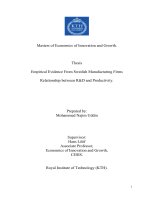
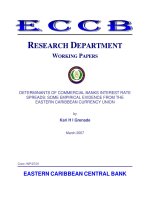
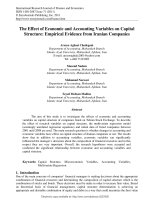
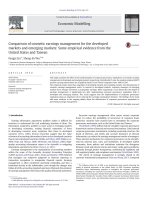

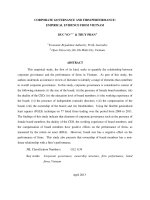
![kwon et al - 2014 - the effect of mandatory audit firm rotation on audit quality and audit fees empirical - evidence from the korean audit market [mafr]](https://media.store123doc.com/images/document/2015_01/06/medium_har1420548188.jpg)


